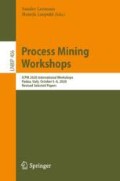Abstract
Many process mining tools produce directly-follows graphs (DFG) as visual representations of event logs. While the “directly follows” relation is a good starting point for visualizations, there are simple phenomena it does not capture, for instance, when whether or not an event directly follows another event depends on the event directly preceding it. We call this a history dependency. This paper presents an empirical study of preferences for visualizing history dependencies: plain DFGs and two enhanced variants of DFGs (with additional arcs or rectangles) are evaluated. Our empirical study provides strong support for making an effort (to discover and) to explicitly visualize history dependencies. A ProM plug-in generating such explicit visualization is described in this paper.
Access this chapter
Tax calculation will be finalised at checkout
Purchases are for personal use only
Notes
- 1.
Students of the “Advanced Process Mining” course also attended the course “Process Mining” in the winter term and thus had advanced process mining knowledge.
References
van der Aalst, W., Günther, C.: Finding structure in unstructured processes: the case for process mining, pp. 3–12, August 2007
Berge, C.: Graphs and Hypergraphs. North-Holland, New York (1973)
Ellson, J., Gansner, E.R., Koutsofios, E., North, S.C., Woodhull, G.: Graphviz and dynagraph - static and dynamic graph drawing tools. In: Jünger, M., Mutzel, P. (eds.) Graph Drawing Software. Mathematics and Visualization, pp. 127–148. Springer, Heidelberg (2003). https://doi.org/10.1007/978-3-642-18638-7_6
Goedertier, S., Martens, D., Baesens, B., Haesen, R., Vanthienen, J.: Process mining as first-order classification learning on logs with negative events. In: ter Hofstede, A., Benatallah, B., Paik, H.-Y. (eds.) BPM 2007. LNCS, vol. 4928, pp. 42–53. Springer, Heidelberg (2008). https://doi.org/10.1007/978-3-540-78238-4_6
van Hee, K., Oanea, O., Serebrenik, A., Sidorova, N., Voorhoeve, M.: History-based joins: semantics, soundness and implementation. In: Dustdar, S., Fiadeiro, J.L., Sheth, A.P. (eds.) BPM 2006. LNCS, vol. 4102, pp. 225–240. Springer, Heidelberg (2006). https://doi.org/10.1007/11841760_16
Leemans, S.J., Poppe, E., Wynn, M.T.: Directly follows-based process mining: a tool. ICPM 2019, 9–12 (2019)
Moody, D.: The “physics” of notations: toward a scientific basis for constructing visual notations in software engineering. IEEE Trans. Softw. Eng. 35, 756–779 (2010)
Sun, H., Du, Y., Qi, L., He, Z.: A method for mining process models with indirect dependencies via petri nets. IEEE Access 7, 81211–81226 (2019)
van der Aalst, W.M.: A practitioner’s guide to process mining: limitations of the directly-follows graph. Procedia Comput. Sci. 164, 321–328 (2019)
Wen, L., Wang, J., Sun, J.: Detecting implicit dependencies between tasks from event logs. In: Zhou, X., Li, J., Shen, H.T., Kitsuregawa, M., Zhang, Y. (eds.) APWeb 2006. LNCS, vol. 3841, pp. 591–603. Springer, Heidelberg (2006). https://doi.org/10.1007/11610113_52
Author information
Authors and Affiliations
Editor information
Editors and Affiliations
A Rigorous Definitions
A Rigorous Definitions
Let \(\mathcal A\) be a finite set of activities without \(\rhd \) and \(\square \). A trace is a finite sequence \(\rhd A_0 \dots A_n \square \) which satisfies \(A_i \in \mathcal A\) for every \(i \le n\). An event log is a finite non-empty set of traces.
A directly-follows graph with multiplicities (DFG+) consists of a finite set V of vertices, a finite set \(E \subseteq V \times V\) of edges, and a labeling function \(\lambda :V \rightarrow \mathcal A \cup \{\rhd , \square \}\) such that V together with E is a directed acyclic graph (DAG), there is exactly one vertex labeled \(\rhd \), and this vertex is the only vertex with no incoming edge, there is exactly one vertex labeled \(\square \), and this vertex is the only vertex with no outgoing edge. A DFG+ represents the event log which consists of the labelings of all paths through it that are traces.
A DFG+ is a directly-follows graph (DFG) when every event is the label of at most one vertex. A DFG+ is reduced if every vertex is on some path from the vertex labeled \(\rhd \) to the vertex labeled \(\square \) and there are no two distinct vertices with the same set of successor vertices.
Fact. For every event log there is, up to isomorphism, exactly one reduced DFG+ that represents it. Such a DFG+ is called canonical for the event log.
Definition. Let \(\mathcal D\) be a canonical DFG+ for an event log. 1. The event log is history-free if \(\mathcal D\) is a DFG.
2. Let k be a non-negative integer and \(A \in \mathcal A\). There is a k-conflict for A if there are paths \(v_0 v_1 \dots v_{k}\) and \(w_0 w_1 \dots w_{k}\) in \(\mathcal D\) such that \(v_k \ne w_k\), \(\lambda (v_i) = \lambda (w_i)\) for all \(i < k\), and \(A = \lambda (v_k) = \lambda (w_k)\). There is a k-history dependency (\(k>0\)) for A if there are no k-conflicts for it, but a \((k-1)\)-conflict.
Rights and permissions
Copyright information
© 2021 Springer Nature Switzerland AG
About this paper
Cite this paper
Wetzel, M., Koschmider, A., Wilke, T. (2021). Visually Representing History Dependencies in Event Logs. In: Leemans, S., Leopold, H. (eds) Process Mining Workshops. ICPM 2020. Lecture Notes in Business Information Processing, vol 406. Springer, Cham. https://doi.org/10.1007/978-3-030-72693-5_1
Download citation
DOI: https://doi.org/10.1007/978-3-030-72693-5_1
Published:
Publisher Name: Springer, Cham
Print ISBN: 978-3-030-72692-8
Online ISBN: 978-3-030-72693-5
eBook Packages: Computer ScienceComputer Science (R0)

